The secrets of Sicily…
I do love a story set in Sicily where I worked for a couple of years back in the 1970s. Eek! Where has time gone? I met my lovely husband there, so it holds a special place in my heart, so I was delighted to come across lovely Jan Bayham and her book published back in 2023. The Secret Sister really captured my attention. I asked Jan about her research and she also offered really useful writing tips.

A big thank you to you, Angela, for inviting me onto your lovely blog as part of your series on Writing Tips. I’ve always enjoyed reading novels set in the past, especially if I’m also transported to a different location from the one I’m familiar with. It came as no surprise to me that when I began writing historical fiction, I also wanted to transport my own readers to differing locations. That meant one thing, research. Not only did I need to research the time in which the stories were set and avoid anachronisms, I also needed to walk in my characters’ footsteps when they visit a new country for the first time, sample what they eat and drink, smell and hear what they do.
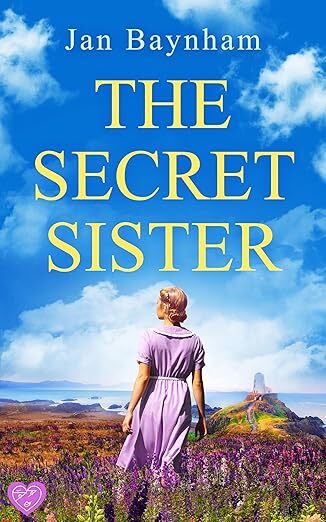
My fourth novel, The Secret Sister, is set in rural mid-Wales where Carlo Rosso, an Italian POW, is interned. As an artist before the war, he is given the task of transforming a dilapidated Nissen hut into a beautiful chapel in which his fellow prisoners can worship. There was no money for materials. I researched making coloured dyes from boiling fruits and berries, onions-skins and tea leaves. I also travelled to west Wales to visit the Henllan Bridge Prisoner of War camp, that had been home to 1,200 Italians. Although I’d read about the Catholic chapel there, nothing prepared me for the beauty and feel of it, and seeing the ingenuity of the POWS by making such a special place from found and scrap materials.
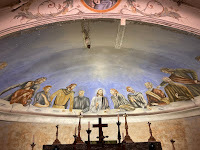
I came away with ideas about the role Carlo played in creating a similar chapel for his fellow prisoners in my novel. On one of its open days, I made a visit to Hut 9, a preserved POW camp near Bridgend to experience what prison life may have been like for him.
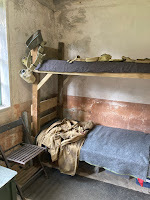
However, the highlight of my research was a visit to Sicily itself, armed with a list of planned visits and questions to ask that had arisen when writing the novel’s first draft. We booked the help of a well-respected WWII guide, asking him to concentrate on the Cathedral, the Allied landings in 1943 and the underground tunnels that were used as bomb shelters at that time. In my novel, while Carlo was interned in a POW Camp in Wales, his mother used the tunnels to keep herself safe from the bombings from the Allied forces and US Airforce. The bonus was to hear from the guide personal anecdotes and stories that you don’t get from history textbooks. In my story, something is hidden away for safety and I found just the place deep underground in one of the tunnels! On another day, visiting the beautiful Casa Cuseni provided inspiration for Villa Cristina in the novel.
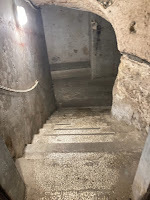

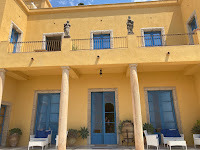
My writing tip regarding research for a novel is to experience as much as you can yourself. Put yourself in the characters’ shoes, walk where they walk, imagine their feelings and ask for personal stories from the time in which your story is set.
I couldn’t agree more, Jan. If we are fortunate enough to be able to research in situ, it gives us greater depth to our writing. If we know our story locations personally, then we should be able to draw our readers more easily into the story. Thank you so much for coming to talk to me and I look forward to reading more of your wonderful #historicalnovels. p.s. Have you read the wonderful story about a similar chapel on the Island of Orkney?
My review for The Secret Sister is posted further below.
Blurb for The Secret Sister
Wales, 1943.
Sara Lewis should be heartbroken when her husband doesn’t return from war. But he was never the kind husband she hoped for. Maybe this could be the new beginning she’s always wanted. She and her young son move from her husband’s farm to live with her sister.
Despite herself, she begins to notice handsome Carlo. An Italian prisoner of war in Wales, he has been volunteered to work in her brother-in-law’s builders’ yard. Longing looks soon turn into love letters and a connection neither of them can sever. But fraternization between the prisoners and local women is strictly forbidden. As their love grows, so does the danger all around them . . .
Twenty-five years later, their daughter holds her father’s hand as he takes his last breath and whispers a name: Giulietta. But who is Giulietta, and who are the young woman and baby in an old photograph?
The secrets of the past collide as the family is shaken to its very core, forced to revisit memories they’d rather forget to uncover the truth.
Perfect for fans of Fiona Valpy, Barbara Davis, Karen Swan, Amanda Weinburg or Anita Chapman.
About the author
Fascinated by family secrets and ‘skeletons lurking in cupboards’, Jan’s dual narrative, dual timeline novels explore how decisions and actions made by family members from one generation impact on the lives of the next. Her first three novels look at the bond between mothers and daughters as well as forbidden love. Setting and a sense of place plays an important part in all Jan’s stories and as well as her native mid-Wales, there is always a contrasting location – Greece, Sicily and northern France. Her next three books will involve secrets and sibling relationships; the first, The Secret Sister, set in 1943 and 1968 takes the reader back to beautiful Sicily where two sisters work together to prove their father’s innocence of a wrongdoing. The Silent Sister will be published on August 7th. Partially set in Kefalonia at the time of the devastating earthquake, it involves a young girl who is pulled from the rubble where her parents and grandparents have perished. The third ‘sister’ book, The Stolen Sister, is partially set in Crete and will be published in early 2026.
Originally from mid-Wales, Jan lives in Cardiff with her husband.
My review:
Mystery and Romance in Sicily
I enjoyed this dual time mystery story laced with romance and the way the author decided to relate the story in the past in the first half of the book. Sometimes when the story jumps back and forth, it is easy to lose the thread. But not with The Secret Sister.
I’ve also looked into accounts of Italian POWS working as co-operators for the British during the war and really enjoyed this part in particular: how prisoners “were not allowed to fraternise with the locals”. When you have young people who fall in love, this is difficult and I have met Italian POWs here in Italy who have told me about their British affairs – including one who asked me not to tell his (Italian) wife…
These prisoners were kept on long after Italy signed the Armistice to join the allies, so they were unable to join their loved ones back home for a long time. Small wonder that love blossomed for some. Italians are so artistic and the creation of the little cappella for worship, the ways they found to make candlesticks out of tins and paint with whatever they could get hold of, was not only a crucial part of the story, but testament to the ingenuity of these prisoners of war.
I enjoyed the hints in the first half which suggested that Carlo might have more of a story to him back in Sicily that he needed to hide. I think the cliff-hangers are excellent and made me want to read on to find out what might have happened. “But then, without warning, another beautiful face with ebony hair…” entered his mind… and “there was one reason he hadn’t shared with anyone that meant he could not set foot on Sicilian soil again…”
The intrigue kept me turning the pages so that I was ready for a mystery to be solved in the second half. What it was and if it was solved, you will have to find out for yourselves, but there is a good balance of romance in the “modern” sixties timeline and I enjoyed being transported back to Sicily, where I used to work in the 1970s. This beautiful island is brought to life with clever brush strokes on the pages, with its stunning coastline, busy piazze and delicious dishes.
It’s a feel-good read with depth and I enjoyed the way the mystery was solved. Congratulations to Jan Baynham!
To find out more about Jan, she may be contacted on:
X/Twitter – @JanBaynham https://twitter.com/JanBaynham
Facebook – Jan Baynham Writer https://www.facebook.com/JanBayLit
Instagram – janbaynham https://www.instagram.com/janbaynham/?hl=en-gb
BlueSky – Jan Baynham https://bsky.app/profile/did:plc:jgoaog2fy7svcmuoz3r2zqk3
Blog – https://janbaynham.blogspot.com
Buying Link
The Secret Sister – https://www.amazon.co.uk/Secret-Sister-breathtaking-family-sixties-ebook/dp/B0CD86JDLF/
Amazon UK: https://www.amazon.co.uk/stores/Jan-Baynham/author/B085DC6BKR?
Amazon US: https://www.amazon.com/stores/Jan-Baynham/author/B085DC6BKR?



